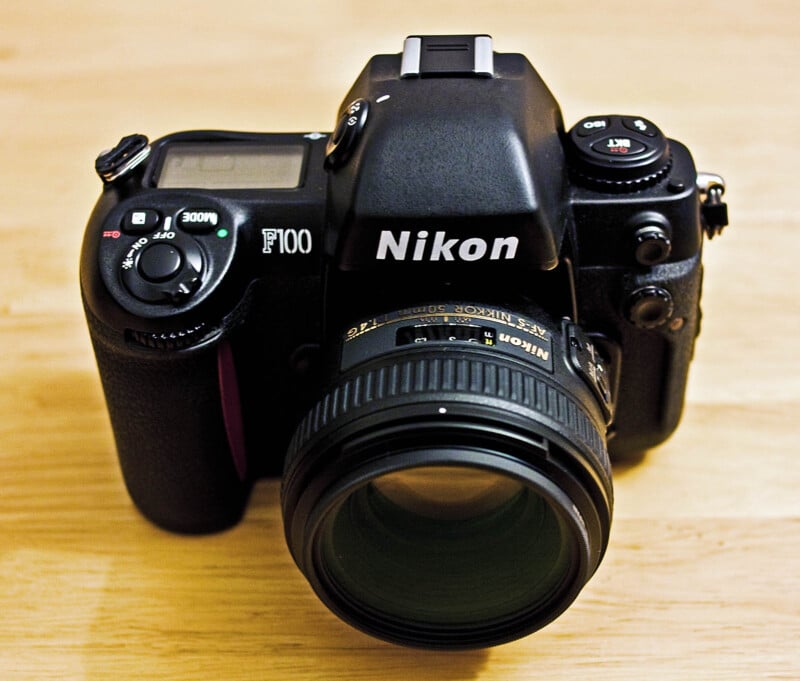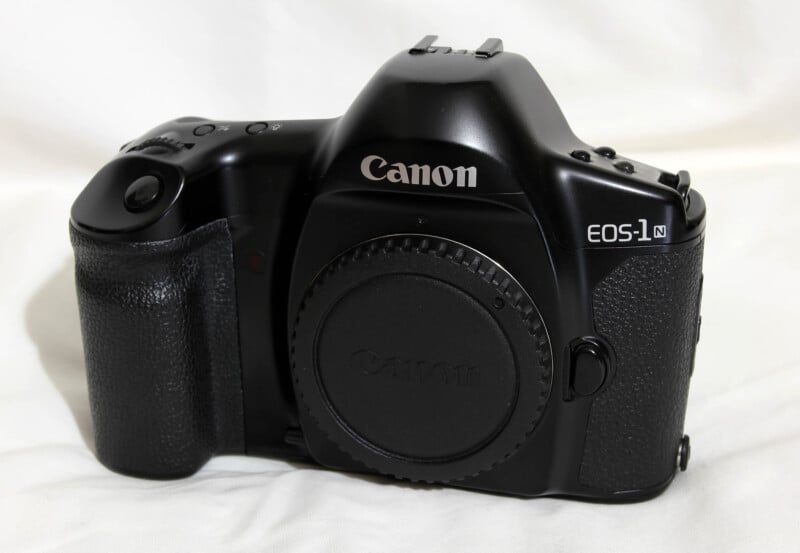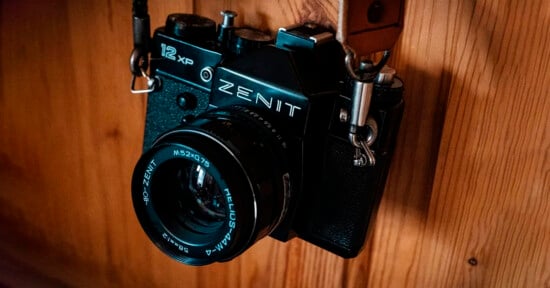The Best Cheap Film Cameras for Beginners in 2024

Film is not making a comeback, it has come back. Photography students I teach are always so excited to start their journey in shooting, developing, and enlarging film, until they start.
So, I thought I might share a few cameras that I typically recommend to students, cameras that aren’t as likely to get in the way of the joy of shooting. If you don’t see your favorite camera below, it’s not personal. I probably love your favorite camera and I love that you love your favorite camera. I have a bunch of cameras not on this list that I deeply love, but can be a little finicky.
It would also be really easy to list off a bunch of super high-end cameras and talk about how awesome they are. However, if you are just getting started, a solid-performing camera that doesn’t cost you a kidney is really important.
So, I would like to offer my humble perspective as a long-time film-camera hoarder and resident broken camera troubleshooter for our students. Here are a few cameras that I have found to be both reliable and easy(ish) on the bank account.
Table of Contents
A Quick Word on Batteries
Everyone loves the vibe of those ’60s and ’70s film cameras. Fuji has practically built a brand on it in recent years; Nikon has capitalized on it with the Df and now with their Zfc camera. Those cameras are iconic and beautiful and old. The old part can be a bit tricky, particularly in the way in which these cameras are powered.
There were a few “standard” batteries that cameras utilized. Some cameras like the Canon AE-1 utilized a 28a battery, which is still available, although slightly expensive. Some of the weirder camera batteries have adapter options that simplify powering them. Take the Yashica Electro for example, it is far more cost effective to purchase an adapter and utilize a 4LR-44 than the alternatives. For this conversation, we will be focusing on two common battery types to pay attention to.
Many cameras like the Pentax K1000 utilize an LR44 battery. They provide 1.5 volts and are cheap and still very easy to find. Some cameras like the Nikon FM utilize two stacked LR44 batteries or one CR-1/3N 3v battery. Through my experiences, I have come to really appreciate the simplicity that these batteries provide in powering cameras.
That being said, some of my favorite cameras are powered by mercury-based PX625 or PX13 batteries. These provided a voltage of 1.35v and can prove to be a bit of a nuisance. The mercury cell batteries are no longer available due to… well… mercury. These batteries are roughly the same height as the LR44, and many folks simply use a small o-ring to adapt an LR44 to the correct diameter of the battery chamber. While this does function, the corresponding voltage difference causes the meter to believe that there is more light than there really is, causing the film to be under-exposed.
There are several legitimate solutions to this problem should you encounter this.
- The first one would be to purchase Wein batteries, but they are quite expensive and always seem to die right when it is most inconvenient.
- The second would be to purchase and utilize A312 hearing aid batteries at 1.35v. They need a little shimming for thickness and o-rings to correct for diameter, but they work.
- You can have the camera adjusted to offset the additional voltage, but this can be a bit tricky and probably better left to a professional.
- You can utilize a Schottky diode either in an adapter like the one sold by Small Battery Co or you can modify your camera (or have it modified) to permanently work with the 1.5v batteries.
- You can also 3D print an adapter for the Schottky diode. They are quite small, so if you can use a resin printer, that is probably best. This adapter has worked well for me.
- Finally, you can just under-expose your film by comparing the meter reading from your film camera with that of another camera and get it close. At the end of the day, the latitude of most films should be such that unless you shoot a lot of E-6 slide film, it should be close enough.
So, the first thing that I would recommend when considering any camera is what type of battery it uses. If any of the above information made you want to quit reading, you should probably go for something that uses an LR44 battery. Personally, I utilize the 3D-printed Schottky diode method and have been extremely happy with the results. Okay, on to the fun part.
Vintage 35mm Cameras
I gravitate to cameras that can be utilized even when the battery is dead. All of the following cameras can operate in this way and if you memorize the Sunny 16 Rule, you can still shoot with this camera. Because I know the film community to be very passionate, I would like to reiterate that the absence of your favorite camera below does not mean that I don’t think you are awesome.
Pentax K1000

Cost: $75-$125
In the entirety of my 33 years in photography, I have only ever seen one truly broken K1000. The one that I did see, looked like it got in a fight with a forklift. They are wonderful cameras and my general go-to recommendation. They use the LR44 battery and provide reliable meter readings that are easy to understand. The Pentax Takumar lenses are sharp, have great color rendition, and when paired with this camera, they provide a stable and reliable starting point for any photographer. If you can’t decide what to buy, buy this.
Canon F-1

Cost: $125-$200
From 1971 to 1981, the F-1 was Canon’s professional model camera and both the new and older versions are extremely reliable much like the K1000. The Cds TTL metering system tends to still be very accurate even 50 years later and the FD lens system is remarkably robust.
There are two downfalls worth mentioning for this camera. First is the 1.35v mercury battery mentioned above. The second is the overall weight of the camera. The F-1 body weighs a whopping 820g or 1.8 pounds compared to the Nikon FM at 590g. Now, weight may not be that big of a concern for everyone, and it is nice to have a camera that could double as a blunt-force trauma-inducing self-defense apparatus. For me, if I’m running to catch the metro, I don’t love the not-so-gentle kidney punches this provides. Small price to pay for great art, but something to keep in mind.
Nikon FM

Cost: $100-$150
This was my first real film camera. The FM stands for Fully Manual and there is nothing fancy about it, but it is a solid performer. It uses two LR44 batteries and does not need adapting or modification for accurate light meter performance. When paired with the 50mm f/1.8 E series lens, it is a compact and lightweight joy to shoot. I still have my first FM and it works as well today as it did 33 years ago when I got it.
Konica Autoreflex TC

Cost: $25-$50
Some of you may not remember that Konica was a standalone brand before it merged with Minolta in 2003. Truthfully, this is one of the most underrated camera and lens platforms on the market today. For some reason, people seem to have forgotten they existed, but the lenses are incredible and the cameras work well.
The 50mm f/1.7 and the 35mm f/2.8 are two lenses that I consistently travel with and use on my Sony A7 platform cameras. The cameras themselves are reasonably reliable, but not quite as bulletproof as the three mentioned above. However, at this moment, they are so cheap, buying a backup is not cost prohibitive. A TC and a 50mm f/1.7 lens consistently go for under $50 and I have also had good luck with the FS-1 and T4.
The only downside here is that this camera utilizes not one, but two 1.35v mercury batteries. I utilize a stack of 3D printed adapters just like if we were using the original mercury cell batteries.
Modern 35mm Cameras
These cameras don’t look as cool as the vintage ones, but modern camera platforms have significant benefits over vintage cameras. Remember that a camera that came out in 1960 is now 63 years old. Springs break, grease dries up, and magnetic releases for shutters stop being magnetic. Old cameras are great, but if you would like to have a lower frustration entry point, these are worth considering.
Nikon F100

Cost: $150-$200
The F100, in my opinion, is perhaps the best 35mm film camera value on the market. It has interchangeable focusing screens should you wish, it uses AA batteries, the metering and autofocus systems are very reliable, and they take the now remarkably cheap Nikon F mount lenses thanks to everyone jumping ship for mirrorless.
This camera has strong F6 vibes and while it is not the same camera, I have had the opportunity to shoot both quite a lot and I find the F100 keeps up beautifully. I have personally owned and worked with the F3, F4, and F5 cameras. I bought my first F100 as my backup camera and as it turns out, I love the backup more than any of the others.
Canon EOS-1N

Cost: $150-$250
It absolutely baffles me why these are so cheap. In 1994 when they came out, they were the top tier professional body from Canon, they utilize the EF lens mount, the autofocus is fast and accurate for a camera of this generation, interchangeable focusing screens, the buttons are weather-sealed, and they can be found consistently under $200. This is an absolute monster of a camera and again, with so many bailing on the EF mount for the newer R mount, lenses for this are super cheap as well.
Bonus: Medium Format Cameras
Medium format can be a bit tricky to talk about in the context of affordability or value. I would start off by saying that if you are just beginning with shooting film, you should not start with medium format. The film is more expensive per shot and reliable cameras are more expensive than reliable 35mm cameras. Don’t get me wrong, I love medium format, probably too much, but it might not be the best place to start learning. With that said, here are two options that I feel very comfortable recommending when you are ready to take the plunge.
Zeiss Super Ikonta

Cost: $200-$400+
There are a few caveats, to begin with here, but these are largely good-value cameras. Things to watch out for are the version of the lens they have and the condition of the bellows for the camera. These are not interchangeable lens cameras, typically, their Tessar lenses are better performers than the budget Novar lenses. The Tessar lenses were made by Zeiss while the Novar lenses were made by Steinheil or Rodenstock. There are a lot of versions made over a twenty-or-so-year period, so if you are in the market for one, it’s a good idea to study up before purchasing.
As for the bellows, pay close attention to the corners of the folds to make sure there aren’t any holes or pinholes. To test for light leaks, you can open up the back of the camera, put the camera close to a light source (like your phone’s flashlight), and look for light shining through the sides of the bellows.
Agfa Isolette

Cost: $60-$550
This camera is very similar to the Ikonta in things to watch out for. Typically they are not as well-made cameras, and there are a number of different camera/lens combinations. However, they are one of the least expensive places to start and perform well for the price point. My favorite of these cameras is the Isolette III with the Solinar lens version. The Agnar/Apotar lenses are three-element and while good, the four-element Solinar is stunning. I tend to avoid the Isolette and Ikonta cameras that have a built-in light selenium light meter. After 70 years, they rarely work and when they do, they are horribly inaccurate.
Conclusion
The last thing that I would like to recommend is where to shop. I have used KEH.com for years and have always found them to be a reliable source for cameras in the United States. As the US supply of cameras has dwindled, prices have gone up and about 5 years ago our school began purchasing cameras exclusively through eBay from Japan.
In my experience, the cameras are always in better condition than advertised, arrive quickly, and are a very reasonable price. Sometimes the model numbers can vary, so visiting camera-wiki.org is always worth your time. For example, in the US, Canon sold the A2 film camera, in Europe, it was branded as the EOS-5. Knowing what to search for makes all the difference.
Don’t fall victim to the lie that only crazy expensive cameras can produce amazing images. I have had an unbelievable amount of fun shooting street photography with an Olympus Pen EE-2 that I bought at Goodwill for $2. Returning to shooting film is always a refreshing experience that takes me back to a simpler form of photography. Whatever it is that you decide to use, just enjoy using it.



